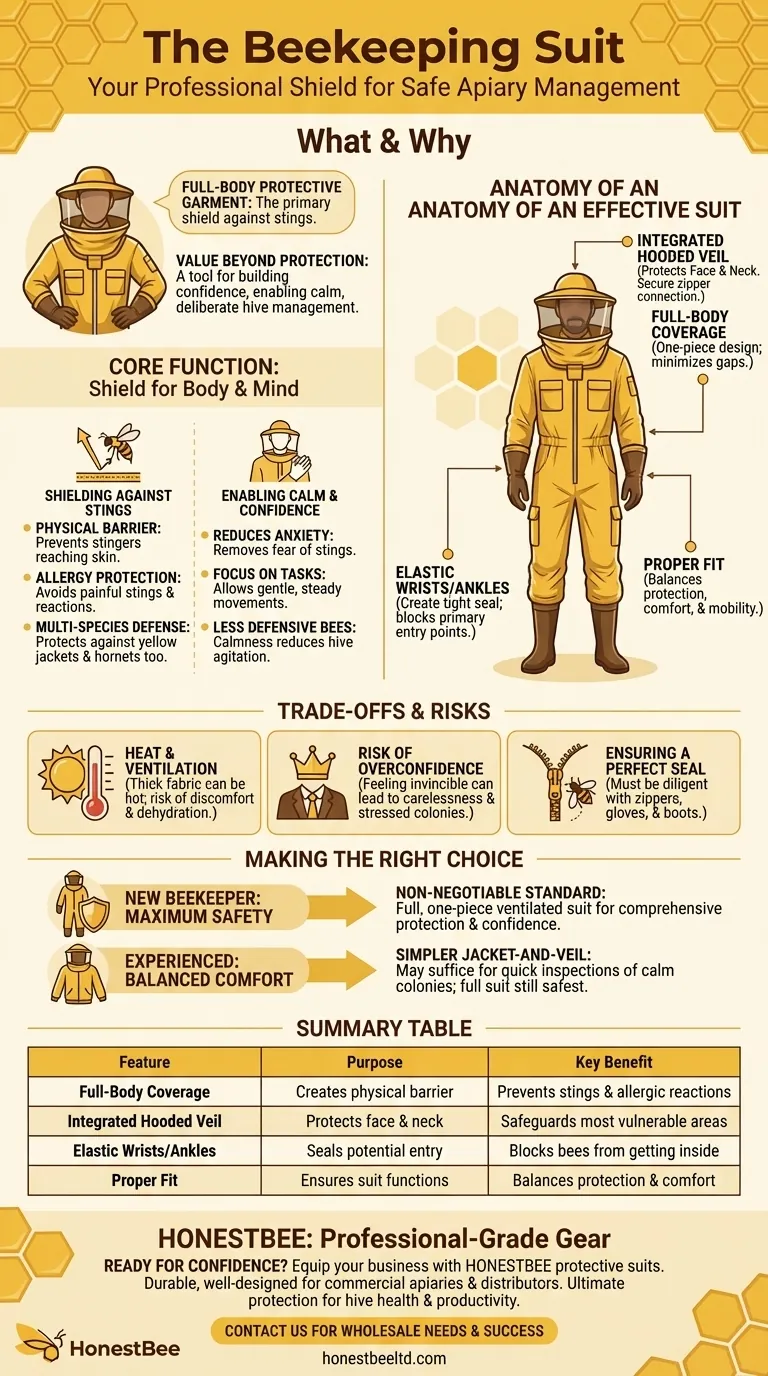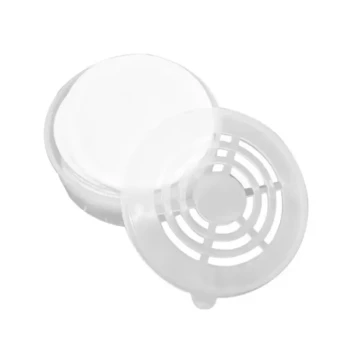In essence, a beekeeping suit is a full-body protective garment designed as the primary shield against bee stings. This single-piece overall, which includes long sleeves and pants, allows a beekeeper to work safely and confidently around a hive. Its main purpose is to prevent painful stings and potential allergic reactions, making it an essential piece of equipment, especially for beginners.
A beekeeping suit's true value extends beyond physical protection; it is a tool for building confidence. By removing the immediate fear of stings, it enables the calm, deliberate movements required to safely and effectively manage a honey bee colony.

The Core Function: A Shield for Body and Mind
A bee suit serves a dual purpose: protecting you from the bees and enabling the right mindset to protect the bees from you. Agitated movements trigger a defensive response, and a suit helps you remain calm.
Shielding Against Stings
The most obvious function is to act as a physical barrier. The fabric prevents a bee's stinger from reaching your skin, protecting you from pain and, more importantly, the potential for serious allergic reactions to bee venom.
Enabling Calm and Confidence
For new beekeepers, the fear of being stung is a significant barrier. A full suit removes this anxiety, allowing you to focus on your tasks and move with a gentle, steady hand. This calmness is less likely to alarm the bees, reducing their defensive behavior.
Protection Beyond Honey Bees
Hives can also attract other, more aggressive pollinators like yellow jackets or hornets. A beekeeping suit offers comprehensive protection against any stinging insect you might encounter while working.
Anatomy of an Effective Bee Suit
A modern bee suit is more than just a piece of clothing; it's a system designed to create a bee-proof seal around your body.
Full-Body Coverage
The foundation is a single garment, or "overalls," that covers you from your ankles to your neck. This one-piece design minimizes the potential for gaps that could appear between a separate shirt and pants.
The Integrated Hooded Veil
The veil is the most critical component, protecting your face and neck where stings are most dangerous. Modern suits integrate the veil directly into the suit with zippers, ensuring a secure connection.
Securing the Entry Points
Bees are experts at finding small openings. For this reason, high-quality suits feature strong elastic at the wrists and ankles. This creates a tight seal, blocking the primary access points for curious bees.
The Importance of a Proper Fit
Your suit should fit well—neither too tight nor too loose. A suit that is too tight can allow stingers to penetrate the fabric, while one that is too loose can be cumbersome and get caught on equipment.
Understanding the Trade-offs and Risks
While essential, a beekeeping suit is not without its limitations. Understanding these helps you use it more effectively and safely.
Heat and Ventilation
The biggest drawback of a full suit is its low ventilation. The thick, protective fabric can become extremely hot, especially during summer inspections. This can lead to discomfort and dehydration if you are not careful.
The Risk of Overconfidence
Feeling invincible inside a suit can sometimes lead to carelessness. A beekeeper might become less gentle or move too quickly, causing unnecessary stress to the colony. The suit is a shield, not an excuse to abandon best practices.
Ensuring a Perfect Seal
The suit is only as effective as its weakest point. You must be diligent in ensuring all zippers are fully closed and there are no gaps between your suit, gloves, and boots where a bee could enter.
Making the Right Choice for Your Goal
When selecting protective gear, your decision should align with your experience level and comfort around bees.
- If your primary focus is maximum safety as a new beekeeper: A full, one-piece ventilated beekeeping suit is the non-negotiable standard for comprehensive protection and building confidence.
- If your primary focus is balancing protection with comfort as an experienced keeper: A simpler jacket-and-veil combination might suffice for quick inspections of calm colonies, but a full suit remains the safest choice for more intensive work.
Ultimately, the right protective gear empowers you to focus less on your own safety and more on the health and well-being of your hive.
Summary Table:
| Feature | Purpose | Key Benefit |
|---|---|---|
| Full-Body Coverage | Creates a physical barrier against stings | Prevents painful stings and allergic reactions |
| Integrated Hooded Veil | Protects the face and neck | Safeguards the most vulnerable areas |
| Elastic Wrists/Ankles | Seals potential entry points | Blocks bees from getting inside the suit |
| Proper Fit | Ensures suit functions as intended | Balances protection with comfort and mobility |
Ready to work with your bees in complete confidence?
Equip yourself or your business with professional-grade beekeeping suits from HONESTBEE. We supply durable, well-designed protective gear to commercial apiaries and beekeeping equipment distributors through our wholesale-focused operations. Our suits are built to provide the ultimate protection, allowing you to focus on hive health and productivity.
Contact HONESTBEE today to discuss your wholesale needs and discover how our equipment can support your success.
Visual Guide

Related Products
- Wholesales Dadant Size Wooden Bee Hives for Beekeeping
- Yellow Plastic Bucket Pail Perch for Beekeeping
- Long Langstroth Style Horizontal Top Bar Hive for Wholesale
- Professional Insulated Plastic Bee Hives
- Professional Insulated Winter Hive Wrap for Beekeeping
People Also Ask
- What are the advantages of wooden bee hives? Superior Bee Health & Beekeeper Flexibility
- What types of products are available for beekeeping needs? Essential Equipment for Apiaries & Distributors
- What is the best place to keep bees? Find the Perfect Apiary Site for Your Hives
- What is beekeeping equipment? Essential Tools for Commercial Apiaries & Distributors
- What should beginners consider when purchasing beekeeping equipment? A Guide to Essential Starter Gear



















